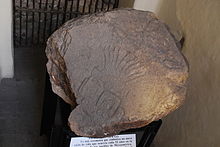- New Fire ceremony
-

Aztec civilization Aztec society Nahuatl language Religion · Mythology · Philosophy · Calendars Human sacrifice · Medicine Aztec history Aztlán · Codices · Warfare Aztec Triple Alliance Spanish conquest of the Aztec Empire Fall of Tenochtitlan · La Noche Triste Montezuma II · Hernán Cortés The New Fire ceremony (in Nahuatl xiuhmolpilli—the Binding of the Years) was an Aztec ceremony performed once every 52 years — a full cycle of the Aztec calendar— in order to stave off the end of the world.
The first Aztec New Fire ceremony described in ethnohistorical sources was in 1090, according to the Mapa Sigüenza. But there is evidence of New Fire ceremonies having been celebrated in civilizations other and earlier than the Aztecs, for example at Xochicalco in the 6th century. According to Bernardino de Sahagún, the last New Fire ceremony was held in 1507; the tradition started and ended with the Spanish conquest of Mexico in 1519–1521.
The fact that New Fire ceremonies had been celebrated before the rise of the Aztec empire suggests that the Aztecs had inherited the ceremony from earlier civilizations of central Mexico and that it was not an original Aztec invention.[1] The Anales de Tlatelolco mention that the Aztecs upon achieving independence of the Tepanec state celebrated a New Fire ceremony that marked the beginning of the calendric count of the Aztecs. This suggests that the ceremony was also used as a dynastic foundation rite.[2]
Contents
The celebration as described in ethnohistorical sources
 The Aztec glyph for a New Fire ceremony, with the year Two Reed (Ome Acatl).
The Aztec glyph for a New Fire ceremony, with the year Two Reed (Ome Acatl). Representation of a new fire ceremony (Codex Borbonicus, p.34).
Representation of a new fire ceremony (Codex Borbonicus, p.34).
The Celebration of the New Fire ceremony is described by Sahagun. During the last five days (called nemontemi) of the last year of the cycle, preparations for the ceremony began. These preparations involved abstinence from work, fasting, ritual cleansing, ritual bloodletting, destruction of old household items and observance of silence.[3] It was believed that during these days the world was in grave danger because of the instability inherent in the shift from one cycle to another. It was feared that female stellar deities, the Tzitzimime, would descend and devour the earth.
At sunset on the last day of the year, a procession of priests from the fire cult of Huehueteotl walked from the ceremonial center of Tenochtitlan across the eastbound causeway towards a mountain called Huixachtlan on the eastern bank of Lake Texcoco close to Colhuacan.[4] The summit of Huixachtlan was visible from most of the Mexico Basin. On this extinct volcano was a temple platform. At this time all fires in the Aztec realm were put out and everyone looked toward the mountain's summit. When the constellation called by the Aztecs "the fire drill" (Orion's belt) rose above the horizon, a man was sacrificed on the top of Huixachtlan and a fire drill was placed on his chest. When the first sparks of fire sprung from the fire drill, the New Calendar Round was declared begun and a huge bonfire was lit. From this bonfire torches were carried by runners to every ward of the city where the temple hearths would be lit. The first fires to be lit in this way were those at the twin temple Templo Mayor where the Tlatoani would participate, and later the fires at the Calmecac of Huitzilopochtli and subsequently the lesser temples and Calmecacs and Telpochcallis and lastly private households.
Archaeology
It has been proposed that archaeological evidence of New Fire ceremonies can be found in the shape of dumps of pottery and households utensils discarded in the initial stage of the celebration. The idea was first proposed by George C. Vaillant in the 1930s but his model was criticized as theoretically unfounded and abandoned. In 2001 Elson and Smith rethought the proposal in light of the findings of several ceramic dumps that seemed to match the idea of what remains of New Fire ceremony would look like. They conclude that New Fire ceremonies were held throughout the Aztec sphere of influence and had a distinct importance at both the local level of each household and in the larger political level of the state religion.
See also
Notes
References
- Elson, Christina; and Michael E. Smith (2001). "Archaeological deposits from the Aztec New Fire Ceremony". Ancient Mesoamerica 12 (02): 157–174. doi:10.1017/S0956536101122078.
- Townsend, Richard F. (2000). The Aztecs (revised ed.). New York: Thames and Hudson.
Categories:- Aztec society
- Aztec mythology and religion
- Aztec calendars
Wikimedia Foundation. 2010.

